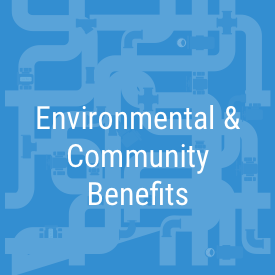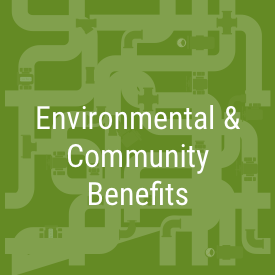This project will develop, compile and use local hydrologic and geomorphic data to identify, design and construct projects to restore and improve natural functions and stability of stream channels.
Geomorphically appropriate channels will be more resilient to damage from more intense rainfall patterns caused by climate change.








See the Environmental & Community Benefits section for complete description of the current Key Performance Indicators (KPIs).
KPI #1: (Hale Creek Enhancement Pilot Project)
In January 2023, Valley Water completed constructing the Hale Creek Enhancement Pilot Project, which extends from upstream of Marilyn Drive in Mountain View to Sunshine Drive in Los Altos. Construction began in June 2022, with in-channel work construction completed in November 2022. The project’s purpose is to restore geomorphic and riparian habitat functions while improving flood protection along a 650-foot-long reach of Hale Creek. The project entailed widening and deepening the creek and restoring natural geomorphic and riparian functions by installing a soft-bottom channel planted with vegetation.
In coordination with the San Francisco Bay Regional Water Quality Control Board (RWQCB), this project has been prioritized and selected for a pilot study to restore geomorphic creek features in a confined urbanized setting.
As part of Valley Water’s commitment to restoring and improving stream channel natural functions, this pilot project will allow Valley Water to examine a new way of converting concrete-lined channels reaching the end of their planned useful life and establishing natural creeks with native plants and healthy creek habitat. Natural channels are more resilient to damage from more intense rainfall patterns caused by climate change.
Following the completion of construction, crews planted native plants along the improved creek channel. The revegetated site will be maintained under the three-year plant establishment and maintenance period, through FY26.
KPI #2: (Bolsa Road Fish Passage Project)
In March 2024, Valley Water completed constructing the Bolsa Road Fish Passage Project. Construction began in June 2023, with in-channel work (including riffle-pool structures, slope protection, benches, and hydroseeding) completed in October 2023. The project installed a gradually sloped riffle-pool stream complex and rehabilitation of the banks adjoining the riffles and pools to achieve a stable channel configuration.
The project restored the stream invert elevation after decades of channel incision and channel bottom lowering. The stream bottom is now elevated over existing fish passage barriers, including a Union Pacific Railroad (UPRR) crossing support slab as well as a non-functional Denil fish ladder that was previously installed to bypass the UPRR crossing. The steelhead trout passage downstream of the UPRR crossing has been restored to provide access to spawning grounds in the upper reaches of the watershed. The project also provides maintenance access for the riffle-pool system, restored banks and vegetation of Uvas-Carnadero Creek downstream of the UPRR crossing.
Following the completion of construction, crews planted native plants along the improved creek channel. The revegetated site will be maintained under the three-year plant establishment and maintenance period, through FY27.
Project Modification: January 2023
On January 24, 2023, the Valley Water Board held a formal public hearing and approved removing KPI #3 “Identify, plan, design, and construct a third geomorphic-designed project to restore stability and stream function by preventing incision and promoting sediment balance throughout the watershed.” The modification was necessitated due to construction cost escalations across the Safe, Clean Water Program impacting the program’s financial health.
April 2024
Key Performance Indicators (FY22–36)
-
Construct the Hale Creek Enhancement Pilot Project, which includes restoration and stabilization of a 650-foot section of concrete-lined channel on Hale Creek, between Marilyn Drive and North Sunshine Drive on the border of Mountain View and Los Altos.
-
Construct the Bolsa Road Fish Passage Project along 1,700 linear feet of Uvas-Carnadero Creek in unincorporated Santa Clara County, which includes geomorphic design features that will restore stability and stream function.
Benefits
-
Uses scientific principles to improve sediment balance and reduce erosion, enhance percolation and reduce instability and sedimentation in creeks
-
Can help reduce annual maintenance cost for sediment removal where erosion and incision problems can be addressed
-
Improves native aquatic habitat
-
Improves the aesthetic value of a stream
-
Addresses climate change
Geographic Area of Benefit
Countywide
About the Safe, Clean Water and Natural Flood Protection Program
In November 2020, voters in Santa Clara County overwhelmingly approved Measure S, a renewal of Valley Water’s Safe, Clean Water and Natural Flood Protection Program.
The program was first passed by voters in 2000 as the Clean, Safe Creeks and Natural Flood Protection Plan, then again in 2012 as the Safe, Clean Water and Natural Flood Protection Program. The renewal of the Safe, Clean Water Program will continue to provide approximately $47 million annually for local projects that deliver safe, clean water, natural flood protection, and environmental stewardship to all the communities we serve in Santa Clara County.
While evaluating ways to improve the 2012 program, Valley Water gathered feedback from more than 21,000 community members. That helped Valley Water create the six priorities for the renewed Safe, Clean Water Program, which are:
Priority A: Ensure a Safe, Reliable Water Supply
Priority B: Reduce Toxins, Hazards and Contaminants in our Waterways
Priority C: Protect our Water Supply and Dams from Earthquakes and Other Natural Disasters
Priority D: Restore Wildlife Habitat and Provide Open Space
Priority E: Provide Flood Protection to Homes, Businesses, Schools, Streets and Highways
Priority F: Support Public Health and Public Safety for Our Community
Each year, Valley Water prepares a report providing a progress update for each of these program priorities, along with fiscal year accomplishments.
To ensure transparency and accountability to the voters, the ballot measure also created an Independent Monitoring Committee, appointed by the Santa Clara Valley Water District Board of Directors. The Independent Monitoring Committee annually reviews the program’s progress to ensure the outcomes are achieved in a cost-efficient manner and reports its findings to the Board. Additionally, the IMC also reviews each proposed 5-year implementation plan prior to its submittal for Board approval.
In addition, the program requires three independent audits.


